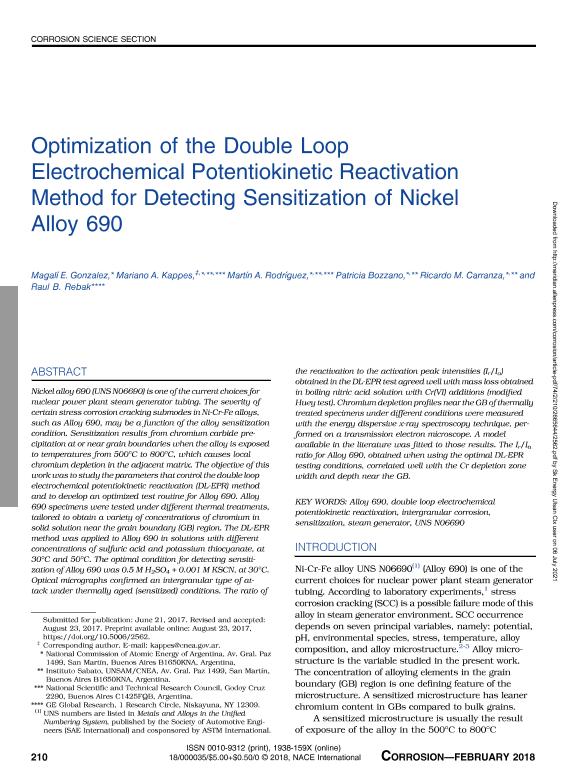Artículo
Optimization of the double loop electrochemical potentiokinetic reactivation method for detecting sensitization of nickel alloy 690
Gonzalez, Magalí Estefanía; Kappes, Mariano Alberto ; Rodríguez, Martín Alejandro
; Rodríguez, Martín Alejandro ; Bozzano, Patricia Beatriz; Carranza, Ricardo Mario; Rebak, Raul Basilio
; Bozzano, Patricia Beatriz; Carranza, Ricardo Mario; Rebak, Raul Basilio
 ; Rodríguez, Martín Alejandro
; Rodríguez, Martín Alejandro ; Bozzano, Patricia Beatriz; Carranza, Ricardo Mario; Rebak, Raul Basilio
; Bozzano, Patricia Beatriz; Carranza, Ricardo Mario; Rebak, Raul Basilio
Fecha de publicación:
02/2018
Editorial:
NACE International
Revista:
Corrosion
ISSN:
0010-9312
Idioma:
Inglés
Tipo de recurso:
Artículo publicado
Clasificación temática:
Resumen
Nickel alloy 690 (UNS N06690) is one of the current choices for nuclear power plant steam generator tubing. The severity of certain stress corrosion cracking submodes in Ni-Cr-Fe alloys, such as Alloy 690, may be a function of the alloy sensitization condition. Sensitization results from chromium carbide precipitation at or near grain boundaries when the alloy is exposed to temperatures from 500°C to 800°C, which causes local chromium depletion in the adjacent matrix. The objective of this work was to study the parameters that control the double loop electrochemical potentiokinetic reactivation (DL-EPR) method and to develop an optimized test routine for Alloy 690. Alloy 690 specimens were tested under different thermal treatments, tailored to obtain a variety of concentrations of chromium in solid solution near the grain boundary (GB) region. The DL-EPR method was applied to Alloy 690 in solutions with different concentrations of sulfuric acid and potassium thiocyanate, at 30°C and 50°C. The optimal condition for detecting sensitization of Alloy 690 was 0.5 M H2SO4 + 0.001 M KSCN, at 30°C. Optical micrographs confirmed an intergranular type of attack under thermally aged (sensitized) conditions. The ratio of the reactivation to the activation peak intensities (Ir/Ia) obtained in the DL-EPR test agreed well with mass loss obtained in boiling nitric acid solution with Cr(VI) additions (modified Huey test). Chromium depletion profiles near the GB of thermally treated specimens under different conditions were measured with the energy dispersive x-ray spectroscopy technique, performed on a transmission electron microscope. A model available in the literature was fitted to those results. The Ir/Ia ratio for Alloy 690, obtained when using the optimal DL-EPR testing conditions, correlated well with the Cr depletion zone width and depth near the GB.
Archivos asociados
Licencia
Identificadores
Colecciones
Articulos(SEDE CENTRAL)
Articulos de SEDE CENTRAL
Articulos de SEDE CENTRAL
Citación
Gonzalez, Magalí Estefanía; Kappes, Mariano Alberto; Rodríguez, Martín Alejandro; Bozzano, Patricia Beatriz; Carranza, Ricardo Mario; et al.; Optimization of the double loop electrochemical potentiokinetic reactivation method for detecting sensitization of nickel alloy 690; NACE International; Corrosion; 74; 2; 2-2018; 210-224
Compartir
Altmétricas



